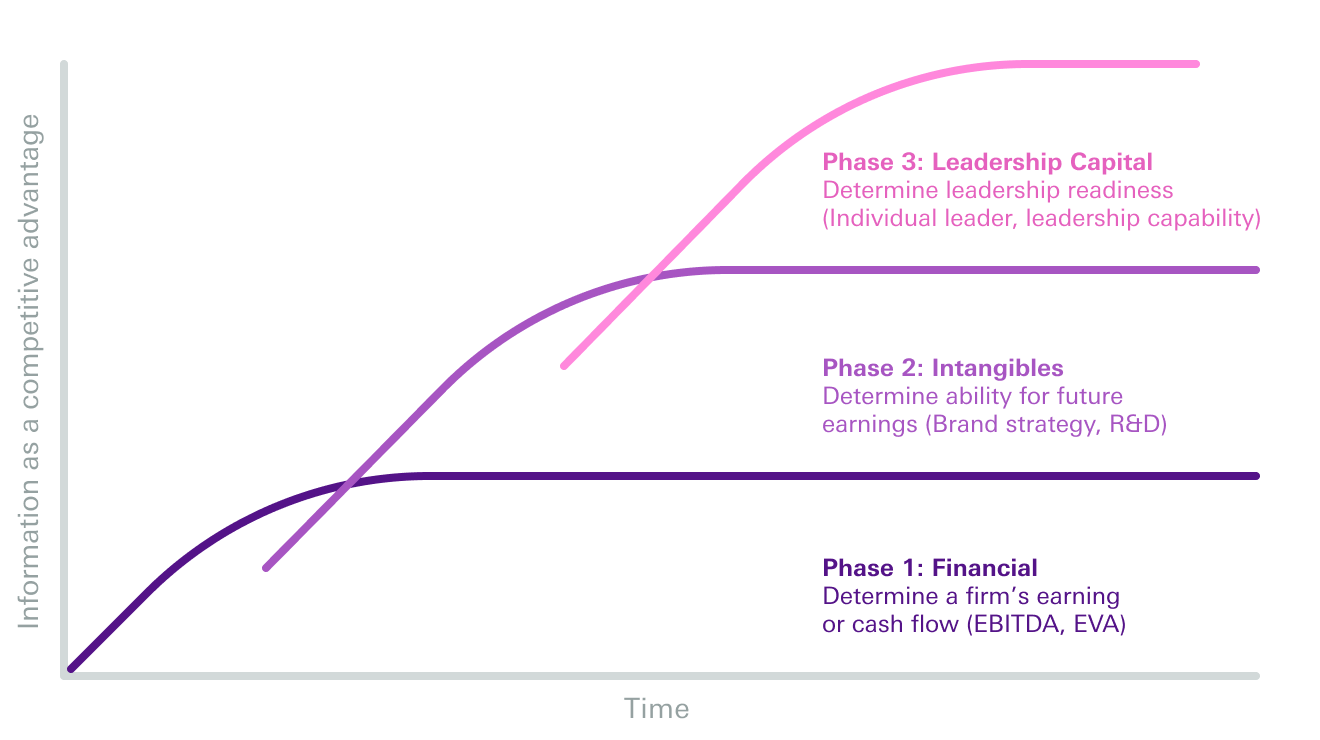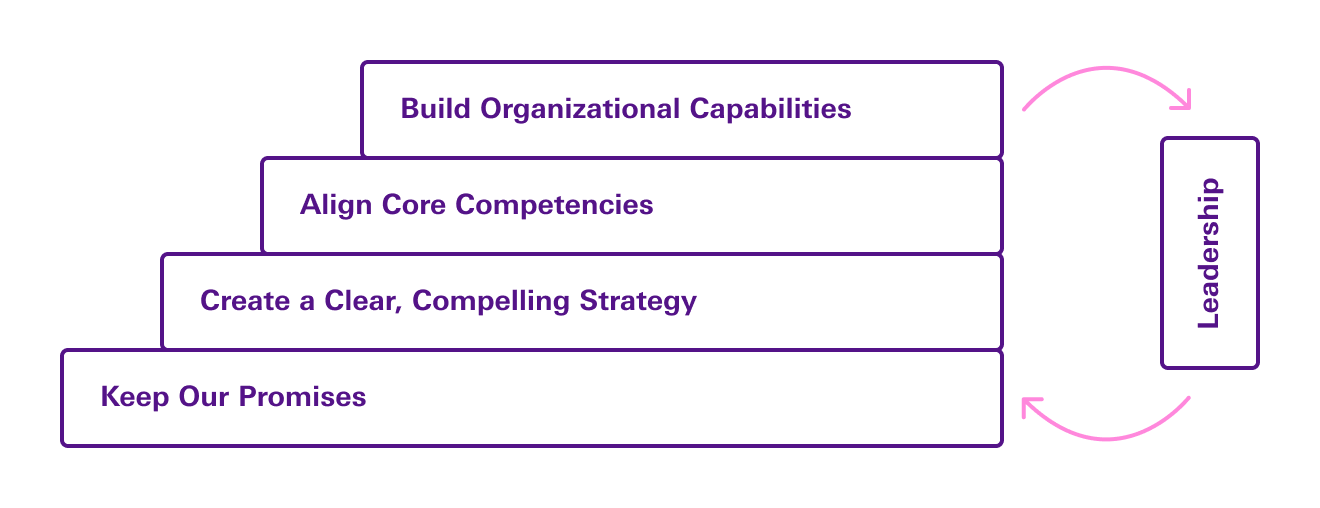What do Apple, Patagonia, and Disney have in common? Their intangibles make them extremely valuable. Apple’s designs, Patagonia’s goodwill, and Disney’s storytelling drive their success. Intangibles are reflected in their stock price and balance sheets. But what if a company’s most valuable intangible is its leadership?
With good reason, investors focus on a company’s financials. But outcomes like earnings, cash flow, and profitability only explain half of a firm’s market value. What accounts for the other half?
Intangibles close some of this gap between financial outcomes and overall firm value. A company’s strategy, brand, innovation, research and development, and goodwill account for some of the differences between companies with the same tangible assets. One factor drives these company decisions: leadership. Even though leadership may seem hard to pin down, decades of research into the who, what, and how of leadership can help us value it like any other intangible.

Let’s explore who makes a good leader, what they do for their organizations, and how to measure this company differentiator.

Who Makes a Good Leader?
The answer may surprise you, but more people can be good leaders than you may think. After spending decades searching for the right traits, researchers couldn’t find one profile of universally good leaders. It helps for leaders to be smart, prudent, and focused on managing both people and tasks. Fortunately, good leadership is trainable: anyone can become a better leader by focusing on five areas.
These include:
- Strategy
- Execution
- Talent Management
- Authenticity
- Emotional Intelligence
Yet it’s what these leaders do that brings value to their organizations.
What do Good Leaders do for Their Companies?
Leadership is more about delivering strategy and creating culture and less about exhibiting a certain personality type. Good leaders must be flexible and adaptive to deliver results in any situation. Good leaders don’t have to be tall, commanding, or have a deep voice. Yet they need to shape employees’ motivation at work, the strategy that differentiates their firm, and the organizational culture.
Two employees, doing the same work in the same company, can have two different workplace experiences based on their leaders. Direct reports that have a strong relationship with their leader have more commitment, helping behaviours, and job performance. Similarly, leaders shape the company’s direction: two business units with the same assets can grow very differently if only one leader uses a clear and differentiated strategy. Finally, leaders shape their organization’s culture through the norms, values, and acceptable actions they model for others. This all connects to the bottom line: as we already explored, company culture drives financial and market performance.
Leadership influences financial performance through company culture, but leaders directly impact firm performance too. Overall, leadership has a 12-14% impact on company performance. When tracking 51 companies over a decade, CEOs accounted for almost 30% of the differences in firm performance. This is four times higher than measures of corporate attitudes and five times higher than industry attitudes. CEOs have even more impact in smaller and faster growing companies.
How can we Measure Leadership?
Intangibles are getting more important. In the last three decades, market value went from about equal to book value to over six times the book value. This means financials only represent $1 out of every $6 of market value. Company attributes like brands, patents, and employee expertise matter more now than in the past. When researchers organized these intangibles into four categories, they saw their common core was leadership.

Leaders drive each category of intangible value in different ways. For companies to keep their promises, leaders must build trust and reduce risk. To create a clear, compelling strategy, leaders must define a desirable future and deliver value to customers. To align core competencies, leaders must invest in R&D and connect functional expertise across departments. Finally, leaders build organizational capabilities by aligning the company’s culture with its mission. Investors who can assess these leadership behaviours gain more information to make more accurate valuations and better investment decisions than their competitors. Dave Ulrich proposes the following:
| Individual | |
|---|---|
| Personal Proficiency | Do leaders have the right personal characteristics? |
| Strategy | Do leaders have a point of view about the future and their company’s strategic position? |
| Execution | Do leaders make things happen and deliver as promised? |
| People Management | Do leaders build competence, commitment, and contribution in their people? |
| Consistency with Values | Do leaders behave consistently with the company culture? |
| Organizational | |
|---|---|
| Culture Building | Do leaders connect the internal and external company culture? |
| Talent Building | Do leaders manage the flow of talent across the employee lifecycle? |
| Performance Accountability | Do leaders create performance management processes that reinforce the right actions? |
| Information Management | Do leaders manage information flow to gain asymmetries? |
| Aligning Work to Strategy | Do leaders create organizational practices that align with the strategy? |
Effective leaders will create value across two domains: individual and organizational. The individual domain captures what a leader or group of leaders is, knows, and does. There are five elements of this domain: personal proficiency, strategy, execution, people management, and consistency with values. The organizational domain captures what leaders do to build the company’s skills and success in the market. The five organizational elements are: culture building, talent building, performance accountability, information management, and aligning work to strategy. Dave Ulrich suggests starting with a manual, qualitative approach to capture this information about leadership.
By measuring these ten elements, investors can find companies with stronger leadership and predict future success more accurately. This takes intangible company valuation to the next level, identifying companies with high potential before they develop the design, goodwill, and storytelling that will set them apart.
Want to dive even deeper?
Check out “The Leadership Capital Index: Realizing the Market Value of Leadership Hardcover” and “Calculating the Market Value of Leadership”

Before you go…
At Orgnostic, we pull together already validated diagnostics on culture and teamwork into a centralized people analytics suite. By building a scalable solution around an integrated leadership capital framework, firms can see how they compare to other companies while getting insights at three levels: individual leadership, mission-critical team design, and organizational culture.